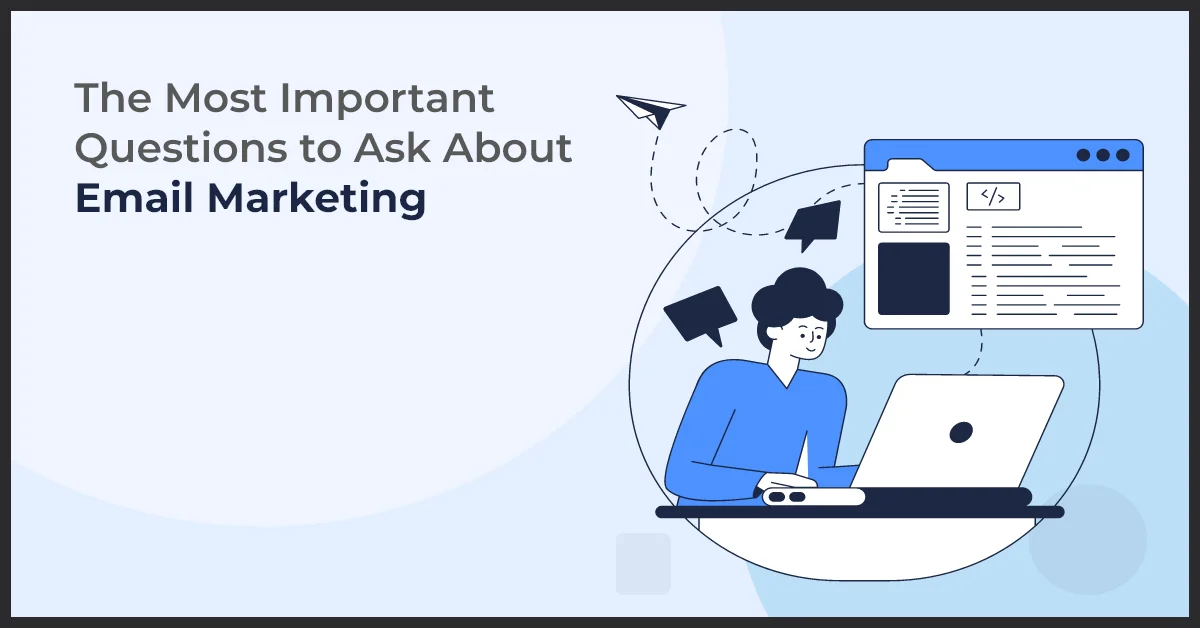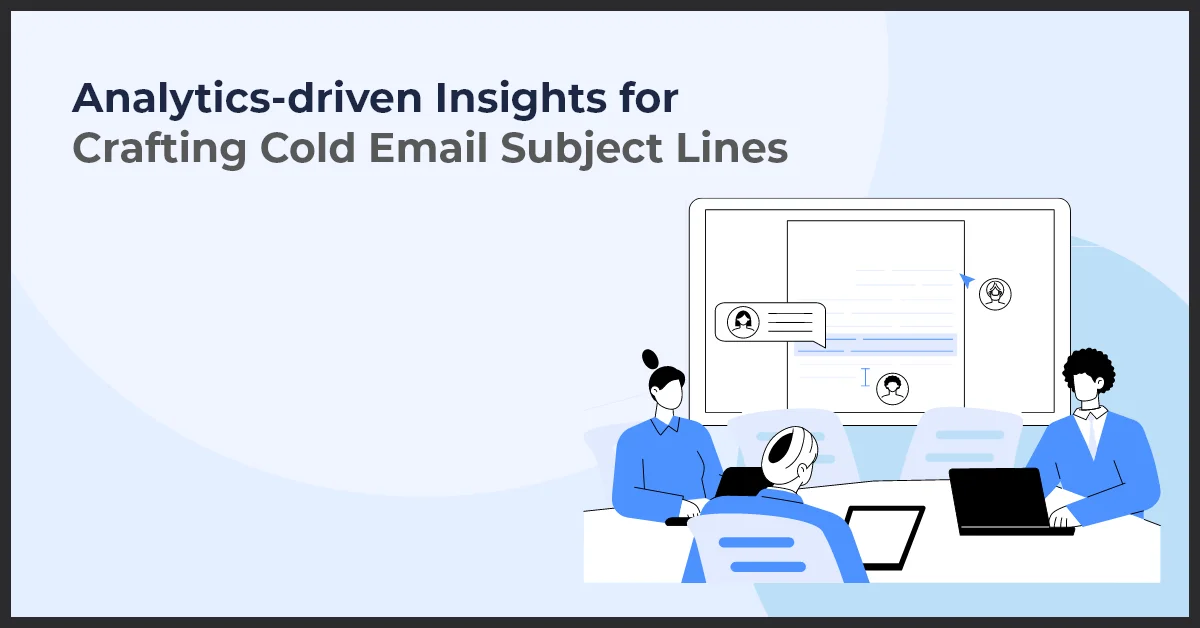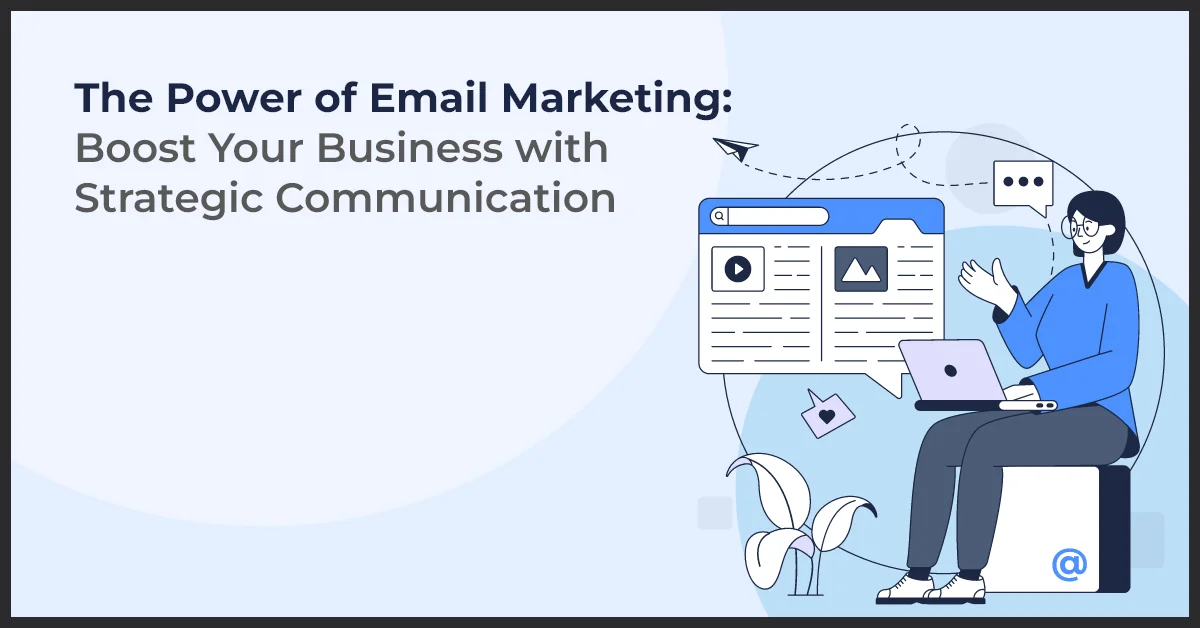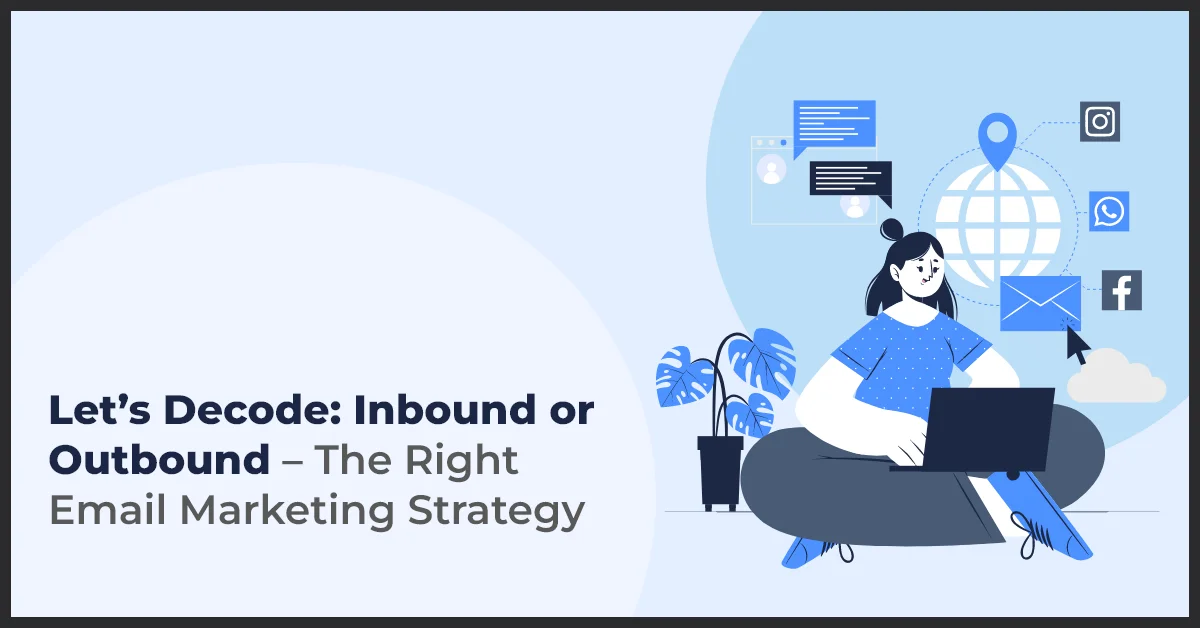Email Marketing: Key Questions to Ask for Better Campaigns

Published on: July 30, 2021
Updated on: March 17, 2025
2359 Views
- Email Marketing
11 min read
Email marketing helps you connect with leads, new & old customers, and prospects that can help you enhance your business. It’s a great opportunity to directly reach their inbox at a convenient time.
If you look at the facts listed below, they clearly show the amazing benefits of email marketing:
- In 2019, the total number of email users was 3.9 billion, and this number is expected to grow over 4.3 billion in 2023, which is half of the total population of the world. This clearly indicates the large audience you can capture through email marketing.
- In terms of return on investment, says a report by DMA, every $1 you invest in email marketing will generate a return of $42.
- A case study by Monetate established that 4.24% of email marketing traffic directly translates into a sale compared to 2.49% of search engine traffic and 0.59% of traffic from social media.
Considering how businesses are increasingly using email marketing to create an impact, it may seem like a deceptively easy task at the first glance. However, once you get into its trenches, you realize the hidden complications.
To help you save the hard work, we have covered some of the most important questions about email marketing in this article that will point you in the right direction.
Let’s start.
Is Email Marketing Still Effective?
Email marketing is one of the most productive marketing tools for any business. It allows you to directly reach your target customers.
Instead of posting something on your website or social media and waiting for people to see it, email marketing allows you to directly reach the inbox of your audience which has a higher chance of engagement.
Even if your target customers don’t open the email, at least they will see the subject line and your company’s name in the sender’s email address. This makes it an effective form of customer engagement.
Is Social Media Marketing Replacing Email Marketing?
Social media marketing has gained immense popularity with the rise of several social media platforms like Facebook, Instagram, Pinterest, Twitter, and more.
It is a powerful marketing tool to increase your traction and connect with the right audience. However, it can’t replace email marketing for these reasons:
- Emails provide a level of professionalism without any privacy issues.
- Email inbox provides a one-to-one channel for customer engagement as compared to social media posts which lack this advantage.
- Even with the immense popularity of social media apps, users still spend 2.5 hours every week checking their email inboxes, and 31% of communication in workplaces is also carried out through emails.
Can You Buy a List When Starting With Email Marketing? How to Build an Email Subscriber List?
It may seem tempting to purchase a subscriber list but you should refrain from using one. Here’s why:
- Using a purchased email list means you are violating ISP and email client guidelines. It will generate a lot of high bounces and get your email address marked as spam by the recipients.
- Reputed email marketing services like GoDaddy and Mailchimp don’t allow purchased email lists. So to use one, you may have to use a service that is likely to be already on the ISP blocklist.
- You will also get a low response rate because the recipients won’t know you or your business.
The best way to build an email subscriber list is organically through your blog or social media pages. By continually engaging with your audience, you can drive them to signup for your emails.
To enhance the process, you can also provide incentives such as a free marketing toolkit, ebooks, and discount coupons to the users who sign up for your email list.
Do You Need to Send an Email Newsletter?
Email newsletters are an effective way to connect with your target audience and push sales. When you invest time and effort in sending regular email newsletters, whether weekly or monthly, your audience keeps your business on top of their minds and remembers how you can help.
It also establishes your authority in your niche or field of expertise and builds a strong connection with your existing as well as prospective customers.
So it is important to tailor your newsletters to your unique audience and analyze what works best for you through experimentation.
How Often Should You Send Marketing Emails?
The best approach is to send emails twice a month and then increase the frequency up to once a week.
If your content is equipped with regular offers and promotions, you can also send emails more than once a week as well. However, it’s important to monitor the performance of your campaign to minimize the bounce rate and to prevent people from unsubscribing.
Another important aspect is to evaluate the best time of the day to send marketing emails. Even though it differs from business to business, the general rule is to target weekends and mornings when your target audience has ample time to read their emails.
How to Make Sure Your Emails Don’t End Up in the Spam Folder?
There are specific guidelines you can follow to stay out of the spam folder. For instance, never write in all caps, it seems invasive and offensive.
Secondly, don’t sound like a salesperson trying to sell a product or service to the customer. Instead, your tone should be friendly coupled without any spelling mistakes or spam trigger words.
Remember that an average person will only spend about 20 seconds reading an email, and anything which takes longer than 20 seconds to read is redundant. So make sure to provide any information or a call to action near the top, where it can be seen without having to scroll down.
Another aspect is to provide accurate and correct information. If your target customer finds out that you’re using superficial stats or showing any information incorrectly, chances are that they will report you spam and unsubscribe from your mailing list.
Got Questions About Email? Find Answers to Common Issues Here!
If you are facing any issues with your email account, you're not alone! Email problems can be frustrating, but fret not, as this guide will help you troubleshoot common issues and find solutions.
1. Login Problems
Are you having trouble logging into your email account? We've got you covered! In this article, we'll provide step-by-step instructions on how to resolve login issues, whether it's due to forgotten passwords, incorrect credentials, or other potential causes.
2. Email not sending or receiving
Struggling with emails that won't send or receive? Don't worry; we'll walk you through the troubleshooting process to ensure that your messages are successfully delivered and received. Learn how to check your settings, resolve server issues, and troubleshoot other common problems.
3. Error Messages
Are mysterious error messages popping up when you try to send or access your emails? Our comprehensive guide will demystify these error codes and messages, enabling you to understand and resolve them effectively. No more scratching your head over cryptic error notifications!
4. Spam Filtering
Tired of sorting through countless spam emails? Discover how to optimize your spam filter settings to reduce unwanted email clutter in your inbox. We'll provide tips and tricks for customizing your spam filter to suit your specific needs, ensuring you only see the emails that matter.
5. Connection Issues
Experiencing difficulty connecting to your email service? In this guide, we'll help you troubleshoot various connection issues, whether it's a slow internet connection, server problems, or conflicts with other software. Get back to smooth sailing and enjoy uninterrupted email access.
No matter the email issue you're facing, we've got the answers you need. Dive into the articles below and solve your email troubles today!
Email Security
Keeping your email accounts secure is of utmost importance in order to protect your personal and sensitive information. Ensure the safety of your emails by following these best practices:
Creating strong passwords
One of the key steps to enhancing email security is creating a strong and unique password. Avoid using common passwords such as your name or birthdate. Instead, opt for a combination of letters, numbers, and special characters.
Enabling two-factor authentication
Add an extra layer of security to your email accounts by enabling two-factor authentication. This feature requires you to provide a second form of verification, such as a unique code sent to your mobile device, in addition to your password.
Identifying and avoiding phishing emails
Phishing emails are designed to trick you into revealing sensitive information or downloading malicious attachments. Be cautious when opening emails from unfamiliar senders or those that seem suspicious. Avoid clicking on suspicious links and never share personal or financial information via email.
Securing email attachments
When sending and receiving email attachments, it is crucial to ensure their security. Scan attachments for viruses and malware before opening them. Be wary of file types that are commonly used to distribute malware, such as .exe or .zip files, especially if they are unexpected or from unknown senders.
By following these email security practices, you can minimize the risk of unauthorized access and protect your valuable data.
Email Configuration
Setting up email accounts on various devices and software programs can sometimes be a confusing process. Whether you're using a smartphone, tablet, or computer, it's important to ensure that your email is properly configured for optimal functionality.
Email client configurations: Each email client has its own unique setup process. Whether you're using Microsoft Outlook, Mozilla Thunderbird, or Apple Mail, you'll need to enter specific settings such as your email address, password, incoming and outgoing server information, and port numbers.
Server settings: Email servers play a crucial role in the configuration process. You'll need to know your incoming and outgoing server names, protocols (POP3, IMAP, or Exchange), as well as the corresponding port numbers. These settings ensure that your email client can communicate properly with the mail server.
Syncing emails across multiple devices: If you use multiple devices to access your email, such as a smartphone, tablet, and computer, it's essential to configure them to sync seamlessly. This ensures that any changes you make on one device, such as deleting or marking emails as read, are reflected across all your devices.
By understanding the email configuration process, you can effortlessly set up your email accounts on various devices and software programs. Proper email configuration ensures a smooth and efficient email experience, allowing you to stay connected and organized.
Efficiently managing emails is essential for staying organized and productive. With the ever-increasing volume of emails we receive daily, it's crucial to have proper systems in place to keep everything in order.
One effective way to organize your emails is by creating folders. By categorizing your emails into different folders based on their topics or importance, you can quickly find what you're looking for without wasting time scrolling through a cluttered inbox.
Additionally, setting up filters and rules can help automate the organization process. Filters allow you to sort incoming emails based on specific criteria, such as the sender's address or specific keywords. This ensures that important emails are prioritized and easily accessible.
Another useful feature to consider is creating email signatures. A well-designed email signature can give a professional touch to your messages and provide essential contact information to recipients.
Furthermore, setting up auto-replies can help manage your email communication when you're unavailable or out of the office. Auto-replies can inform senders that you're away and provide alternative contact information or let them know when they can expect a response.
Managing email storage is also vital to ensure your inbox doesn't get overloaded and slow down your email client. Regularly deleting unnecessary emails and emptying your trash folder can free up space and optimize the performance of your email account.
Overall, effective email organization and management involve utilizing features such as folders, filters, rules, signatures, auto-replies, and proper storage management to keep your inbox tidy and improve productivity.
Wrapping Up
Countless variables govern the performance of your email marketing campaign. While it’s essential to understand and apply the best practices, the more important aspect is to know that it may take some time for you to get acclimatized to the diverse customer requirements and find success in your email marketing campaign.
Still curious about how to run a successful email marketing campaign? Connect with our marketing experts or write to us at info@growthnatives.com.
Frequently Asked Questions
The four types of email marketing are:
- Transactional emails: These are emails sent to facilitate a transaction or provide information about a transaction, such as order confirmations or shipping notifications.
- Promotional emails: These are emails sent to promote products, services, or offers to customers.
Relational emails: These are emails sent to build and maintain relationships with customers, such as newsletters or customer surveys. - Lifecycle emails: These are emails sent based on a customer’s actions or lifecycle stage, such as welcome emails for new customers or re-engagement emails for inactive customers.
Email marketing delivery refers to the process of sending marketing emails to a list of subscribers. It involves ensuring that emails are delivered to recipients’ inboxes and not marked as spam.
The five steps of email marketing are:
- Define your goals: Determine what you want to achieve with your email marketing campaign, such as increasing sales or driving website traffic.
- Build your email list: Collect and maintain a list of subscribers who have opted in to receive your emails.
- Create engaging content: Develop compelling content that is relevant to your audience and encourages them to take action.
- Send your emails: Use an email marketing platform to send your emails to your subscribers.
- Measure and optimize: Track the performance of your emails and make adjustments to improve results.
Some common email marketing strategies include:
- Personalization: Tailoring emails to individual recipients based on their preferences or behavior.
- Segmentation: Dividing your email list into segments based on factors such as demographics or purchase history.
- Automation: Using automation to send timely and relevant emails based on triggers or customer actions.
- Mobile optimization: Ensuring that emails are optimized for viewing on mobile devices.
- A/B testing: Testing different elements of your emails to see what resonates best with your audience.
- User-generated content: Incorporating content created by your customers, such as reviews or testimonials, into your emails.
- Interactive content: Using interactive elements, such as polls or quizzes, to engage recipients and encourage interaction.



